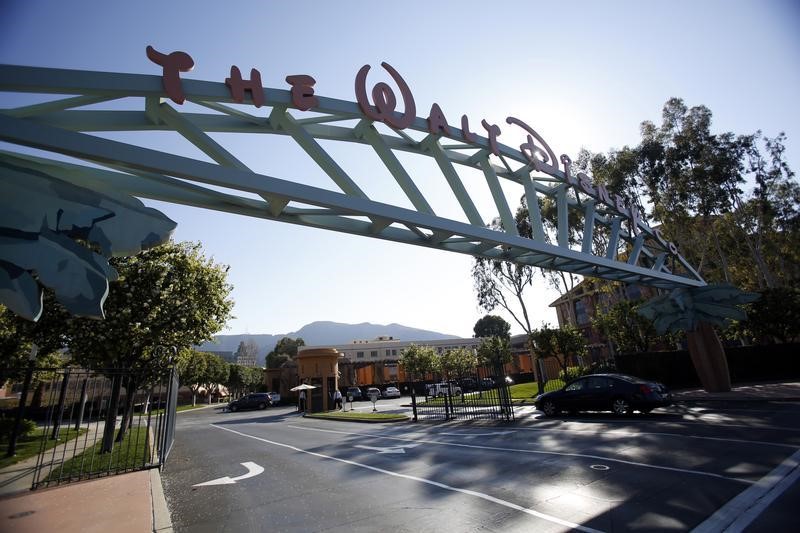© Reuters. FILE PHOTO: Disney and Reliance logos are seen in this illustration taken December 15, 2023. REUTERS/Dado Ruvic/Illustration/File Photo
By Arpan Chaturvedi
NEW DELHI (Reuters) – A proposed merger of Walt Disney (NYSE:)’s and Reliance’s media assets in India could spark intense antitrust scrutiny over their market power, with lawyers flagging concerns that the combined entity’s strong portfolio of cricket broadcast rights could impact advertisers.
The Disney-Reliance $8.5 billion merger would create India’s No. 1 TV player with 120 channels, with local rival Zee closest with 50.
Analysts at India’s Ambit Capital estimate the entity, to be majority owned by billionaire Mukesh Ambani’s Reliance, will have a 35% share of India’s TV viewership.
While the overall TV space will be closely assessed by the Competition Commission of India (CCI), six antitrust lawyers said cricket rights are going to be in spotlight as the regulators examine market share and the power of the combined entity.
Cricket has a fanatical following in India, where many fans worship players as gods. Companies shell out billions of dollars to win broadcast rights or spend on advertisements to lure consumers to their services.
Disney holds TV broadcast rights for world’s most-valuable cricket tournament, Indian Premier League (IPL), as well as both India TV and streaming rights for International Cricket Council’s matches. Reliance has streaming rights for IPL, Indian cricket board’s rights for all matches.
K.K Sharma, a former head of mergers at CCI, said the combined Disney-Reliance combo will raise eyebrows among regulators given the market power they will exert, especially in the cricket segment, requiring “deeper scrutiny.”
“If I was the regulator, I would begin with suspicion,” said Sharma, now a senior partner at Indian law firm Singhania & Co.
“With Disney and Reliance together, hardly anything of cricket will be left. The regulator gets concerned even when there is a possibility of dominance. Here, it is not merely dominance but almost an absolute control over cricket.”
Disney declined comment while Reliance did not respond to Reuters queries. The CCI also did not respond.
Media agency GroupM estimates sports industry spending in India totalled $1.7 billion in 2022, up 49% from the previous year. Cricket accounted for 85% of the spending on sponsorship, endorsement and media.
The companies will approach the CCI for approvals in coming weeks. Disney and Reliance have said they hope to complete the transaction by end of this year or early 2025.
A senior Disney source didn’t comment on the scrutiny the merger may face, but said the company consulted a number of antitrust attorneys and is confident about the deal getting final clearance.
Five other lawyers echoed similar concerns as former CCI mergers’ head Sharma, saying the Disney-Reliance entity’s strong grip on the cricket ecosystem could mean advertisers have less bargaining power.
Vaibhav Choukse, head of competition law at India’s J. Sagar Associates, said the companies can explore so-called “behavioral commitments” such as not adjusting advertising rates for a period of time to assuage concerns of regulators, who could in extreme cases order the entity to divest certain channels or cricket rights.
In a note, Jefferies said the Disney-Reliance entity “will sport the most lucrative cricketing rights in India and has 40% share of the advertising market in TV and streaming segments, allowing it “better ad inventory monetization.”
“The regulator’s concern as far as cricket is concerned will be on the advantage the Disney-Reliance entity will have on raising prices for advertisers,” said Karan Chandhiok, head of competition law at India’s Chandhiok & Mahajan.
Disney and Reliance – before the merger – have competed intensely on cricket. Reliance recently offered free live streaming of Indian Premier League matches for which it had paid $2.9 billion in rights. Later, Disney offered free live streaming of cricket world cup on mobile devices.
The antitrust authorities will also closely look at the TV dominance.
But some lawyers have said the assessment on the TV side could become easier as another media merger between the India’s Zee Entertainment and Japan’s Sony (NYSE:) collapsed this year, leaving more competitors in the market.
Still, lawyers said, Disney-Reliance could face heat on some key TV channel offerings where they together have an outsized market share that is above 40-50%.
A CCI Zee-Sony merger approval document from 2022 shows a Disney-Reliance combination back then would have had a 65-75% market share in Marathi language channels and around 50% in Bengali channels.
This story originally appeared on Investing

